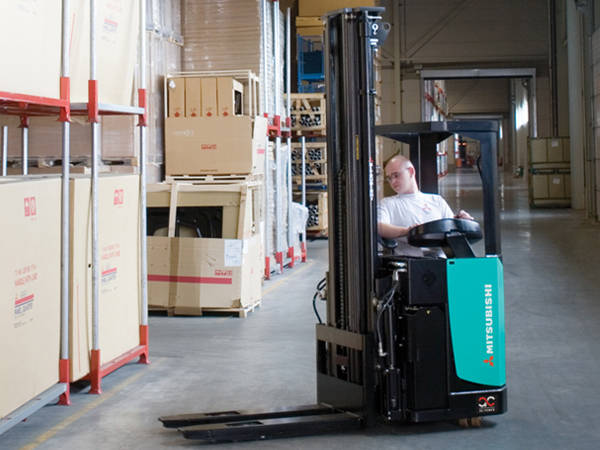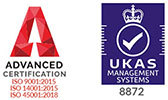Warehouses present several different hazards to business owners, managers and employees. This is usually because of either the nature of the stock you work with and/or the amount of heavy equipment that’s used to get the job done.
As advancements in technology continue, machines, such as
forklifts, are becoming safer, being built with more default protective systems, but then they’re also far quicker and a lot quieter than their older counterparts.
This makes it more likely that a piece of material handling equipment will collide with another vehicle,
warehouse racking or even a person. Mitigate these risks entirely by taking the following precautions when running your warehouse.
Ensure safety equipment is always in use at appropriate times
It’s essential that your employees are wearing PPE, almost all the time. If they’re onsite and working in and around your premises, then they need to be wearing, at the very least, the following pieces of PPE:
- High-visibility jackets or vests
- Hard hats
- Steel-toed boots with ankle support
- Heavy duty gloves
- Goggles
- Masks
Where this might different depending on the stock you work with, it’s still imperative that your warehouse employees are given everything they need in order to keep themselves and others safe.
Further safety equipment may be required depending on the task being carried out. For example, when one of your workers is operating a forklift, they’ll need the right back support. It’s paramount that your employees are wearing and using the right protective equipment in order to get the job done as safely as possible.
Prevent potential safety hazards
If you look around your warehouse, it’s likely that you’ll spot several hazards that could cause harm to either yourself or your employees. For example, boxes that are left in the middle of an aisle need to be moved and placed on warehouse racking so that people do not slip, trip or fall over them.
Make sure your employees know and understand the importance of good housekeeping throughout the premises. As the business owner or the warehouse manager, you might not have time to go around and check the entire property for such hazards, so it’s important that your workers can keep things tidy themselves. However, you should conduct regular checks in order to identify some of the following things:
- Stray cords, string or wire
- Liquid, such as drips, puddles or leaks
- Cracks in racking, walls, floors or ceilings
- Pits on the floor
Identify & mark out any areas that are, or have the potential to be, hazardous
If there are certain areas within your warehouse, or even outside your warehouse, that pose more of a threat to your employees than other areas, then these need to be segregated and marked out as a hazardous zone. You should also make sure that emergency exits and safe routes out of the property are close by and clearly marked.
You can help your employees distinguish between “safe” and hazardous zones by using the following things:
- Signs
- Stickers
- Labels
- Reflective materials
- Lights
Ensure employees are fully-trained & regularly attend safety courses
When you have employees who work in a warehouse, they need to be adequately trained in the art of performing warehouse operations. Much of this training will include health and safety in the workplace and how to maintain it.
Depending on the type of course your employees have been enrolled on, they might be required to go on refresher courses every year or so, just to reiterate the importance of safety in the warehouse.
As well as teaching your employees how to maintain safe surroundings when at work, they’ll also outline the procedures that need to be followed closely, often to comply with regulations that have been set out by the government.
Make sure warehouse racking is secure and sturdy
Warehouse racking, or shelving as it’s often called, is used to house warehouse inventory safely and securely. But it’s only done safely if the racking is sturdy and will not topple over. It should be anchored to a permanent structure so as to avoid this.
However, the way in which inventory is stored or organised can also play a part in ensuring the rigidity of your warehouse racking. For example, if you have particularly heavy loads to house, then place them on the bottom shelf and put lighter loads towards the tops.
Make sure employees are operating vehicles & heavy machinery responsibly
This shouldn’t be a problem if all of your forklift drivers and those who operate other pieces of warehouse machinery have been enrolled on the right training course. Whilst on this course, they’d have been taught about how to use the machine safely as well as how to navigate around the warehouse as safely as possible. This will include, but is not limited to, knowing the following:
- How and when to check blind spots
- The speed at which corners should be taken
- When to use horns, alarms and lights
- How to use the onboard system so as to turn on headlights, for example
- How to steer correctly, particularly when reversing
Carry out fire drills on a regular basis
Where this isn’t related directly to warehouse operations, it’s still imperative, and required by law, for you to be carrying out regular fire drills and to have fire wardens appointed in the case of an emergency. You should also test both the fire and smoke alarms so as to ensure everyone knows what it sounds like.
Your employees should also know exactly where the fire assembly point is. Once you’re satisfied that the drill has been carried out properly, your staff can re enter the building. A fire drill in the workplace is usually carried out once a week. To find out more about fire drills and safety in the workplace,
visit the government website.
Ventilate your premises as much as possible
Where some warehouse owners might not be able to afford to have air conditioning units set up in their premises, especially considering its size, it’s a good idea, where safe to do so, to leave windows and doors open.
However, you must not keep fire doors open, they have to remain closed. The more air you allow to flow throughout the building, the better. This helps to prevent your staff from becoming too hot. You must also make sure your workers are well-hydrated, especially on hot days.
Multy Lift have over thirty years of experience in the material handling industry. We’re pleased to provide our customers across the UK with high-quality, either new or used, material handling equipment. From electric, VNA and LPG forklifts to reach trucks, order pickers and pallet trucks, we’ll have something for you. For more information about the products we have available, get in touch with a member of our expert team today – we’re always happy to hear from you. 





